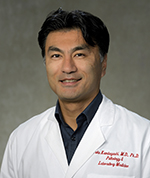Immune/Microbe-Mediated Control of Skin Lipid Secretion and Metabolic Function Across Generations
The immune system and microbes are known to affect various aspects of energy metabolism in organisms. In this seminar, I will discuss our recent findings that have revealed unexpected ways by which the immune system and the microbial environment can affect systemic lipid metabolism. In an acute manner, T cells can control systemic lipid metabolism by inducing lipid secretion from the skin. In addition, T cells and the microbiome affect gametes (sperm and eggs) in a nongenetic manner to induce metabolic and other phenotypic changes in succeeding generations of progeny. Thus, T cells and their response to microbes can affect not only the lipid metabolism of the individual but also of future generations. T cells and microbes could play an important role in organisms for sensing environmental changes, which nongenetically create phenotypic diversity in offspring to hasten natural selection processes for adaptation.
Originally published on May 3, 2024
Lecture Presenter
 | Taku Kambayashi, MD, PhD Professor of Pathology and Laboratory Medicine |
Taku Kambayashi is a professor of Pathology and Laboratory Medicine at the University of Pennsylvania. He is a physician scientist, heading a research lab in basic/translational immunology and an attending physician on the transfusion medicine service at the Hospital of the University of Pennsylvania. He is the chair of the Immunology Graduate Group and the director of the Physician Scientist Training Program for Pathology Residency.
Objectives
After this presentation, participants will be able to:
- Discuss how the immune system can acutely affect lipid metabolism by affecting skin lipid dynamics
- Discuss how the immune system and microbial environment can inform gametes to induce phenotypic changes in succeeding generations of progeny
Sponsored by:
University of Utah School of Medicine, Department of Pathology, and ARUP Laboratories
 Site Search
Site Search






